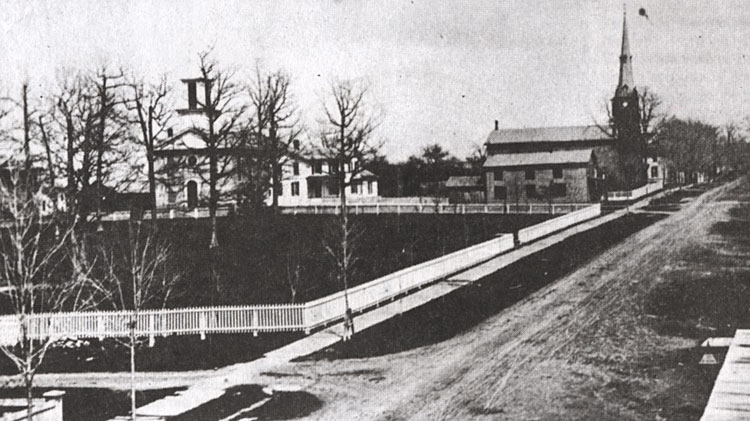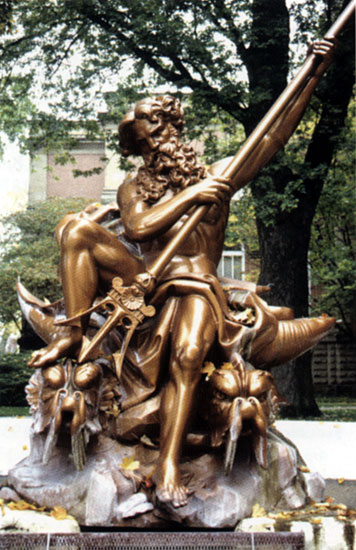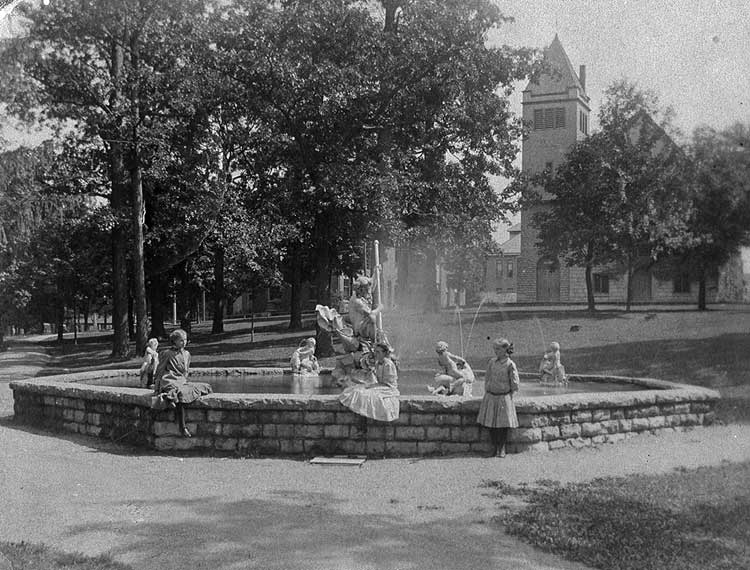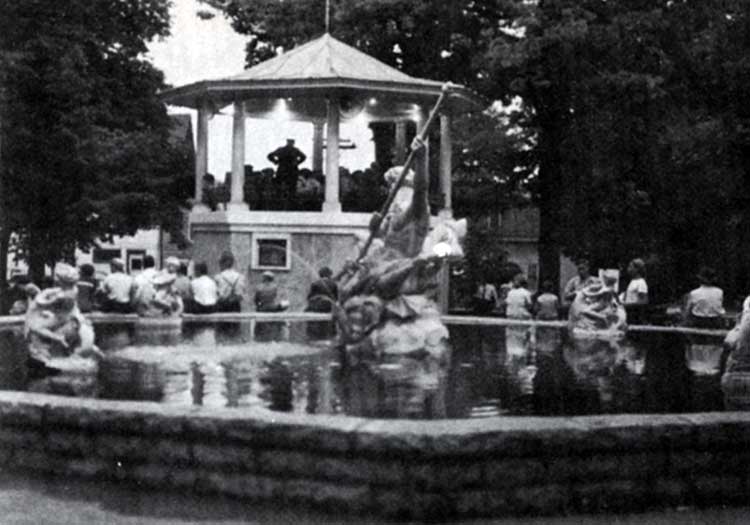King Neptune in Akron's Russell Park

Akron's Main Street, 1870, showing the fenced square that would become Russell Park.
Image source: Newstead Historical Society
Pioneer Jonathan Russell, who came from Sparta in Livingston County in 1826, purchased 120 acres that year in what would become the village of Akron. He set aside land for two churches, a school, cemetery, and park. The park was a square bounded by Main, Church, John, and Clinton Streets. In 1852, his son and daughter-in-law deeded its three acres to the village on the condition that it always remain public.
 Akron formally named the park "Russell Park" in 1898 in honor of its donor and at the same time some residents conceived of decorating the park with a fountain to symbolize the village's prosperity. A committee was formed to raise funds and determine the location and design for the fountain.
Akron formally named the park "Russell Park" in 1898 in honor of its donor and at the same time some residents conceived of decorating the park with a fountain to symbolize the village's prosperity. A committee was formed to raise funds and determine the location and design for the fountain.
The committee's resolve coincided with the heyday of zinc statuary in the United States. The use of zinc, an inexpensive material that could be cast in sections, easily soldered together, and finished to resemble costly materials such as stone or bronze, made it popular for public ornamentation as well as memorial statues to the herioc dead. It is also durable, does not not corrode like iron or bronze or require the cleaning of stone.
The Akron committee likely browsed catalogues by New York City companies such as J.W. Fiske and J.L. Mott that featured zinc statuary and fountains. They settled on a set of fountain figures from J.L. Mott, whose company had copied the Neptune fountain design of French sculptor Vital-Gabriel Dubray. The centerpiece was a larger-than-life size Neptune, holding his trident, seated on rocks and a great shell with sea creatures at his feet.. Water would spray from the the shells and the creatures' mouths and nostrils into a large basin, populated with four boys seated on dolphins that would also spray.
The statuary was ordered through the Akron Hardware Company and arrived in September 1898. The combined figures weighed 2,000 pounds and cost $1,100. Building the basin was a separate expenditure. Locally-quarried stone, "medium blue sandstone," was donated by D.N. Lockwood, owner of the Akron Cement Works. Sand was donated by George Bostwick, cement by Cummings Cement Works. L.F. Brill was the construction contractor for the basin. The fountain figures were painted white by W.R. Burns, who was paid $5.95.
Fountain photo at left is identical to Akron's, now restored in Goshen, Indiana. Image source: "Zinc Sculpture in America 1850-1950" by Carol A. Grissom

Neptune fountain and bandstand, early 20th century. Image source: Newstead Historical Society
Work began in 1899, but winter weather delays, a shortage of money to complete the project, squabbling between the village board and the committee all delayed completion. Finally, in 1901, the fountain was switched on and became a great source of pride to the growing village.
Akron had a band as early as 1850. When the bandstand above was constructed is not known but the band, in its several incarnations, has performed in the summer since before 1900.

Children posing beside the fountain; First United Methodist Church in the background. Image source: private collection
The fountain was a popular location for class photos for students at the school adjacent to the park. "Throughout the day in warm weather it was a place for people to pause for a while and talk: people on errands, young mothers, kids passing by on the way for a refreshment after school...Everyone of all ages enjoyed being near it, listening to the arched streams of water hitting the pool. It was a harbinger of spring. Never announced, the reborn sprays seen sparkling in the sunlight were discovered by a glance from the street. For every child that tested his new toy boat, safely, in the park fountain there could be counted an aged soul sitting alone or with contemporaries reflecting on the past in the shadow of the fountain alive with running water." From the 1974 Newstead Historical Society Quasquicentennial book.

Akron Band performing during one of its summer Saturday night concerts, date unknown. Image source: Newstead Historical Society.

Akron Band using the filled-in basin of the fountain with Neptune still in the center.
Image source: Newstead Historical Society.
By 1948, Neptune's hands, arms, feet and trident were broken beyond repair. In May, 1949, the last figure in the basin, Neptune himself, was removed and concrete filled the basin, creating a platform for the Akron Band. Was he temporarily placed in the center of the platform in the photo above for one last look? Locals say that Neptune was placed, some say discarded, in Murder Creek near the foot of Main Street. No trace of it has been found. The Newstead Historical Society has one of the dolphin figures.
The bandstand, seen above behind the fountain basin, stood until at least 1961.

Russell Park in the 1960's. Image source: Newstead Historical Society.
The 1974 Quasquicentennial book noted that, "No landmark in Akron has come even close to receiving the nostalgic comment that the fountain in Russell Park continues to generate ...If someday a celebration were initiated for the sole purpose of raising funds to restore the fountain to its past splendor it would be the most successful venture undertaken here."

Russell Park bank gazebo built on the basin of the Neptune fountain. 2012
Akron Band concerts continue to be a feature of summer in Akron. In the late 1980's, the Village of Akron authorized construction of a new band gazebo atop the fountain foundation, in addition to the tiered seating seen at right. It was dedicated in June, 1991, just in time for the concert season.
Today there are few alive who recall the fountain during its nearly 50 years of operation.
Dunkirk, NY, had a Neptune fountain; its fate was different than Akron's. It was saved and has been restored. See that story here.
Special thanks to Nancy Eckerson,Town of Newstead, Village of Akron Historian for permitting me to utilize her extensive research on this lost gem. And thanks to Marybeth Whiting, director of the Knight-Sutton Museum of the Newstead Historical Society and volunteer Tom Valentine for their generous assistance and access to their large collection of fountain images.